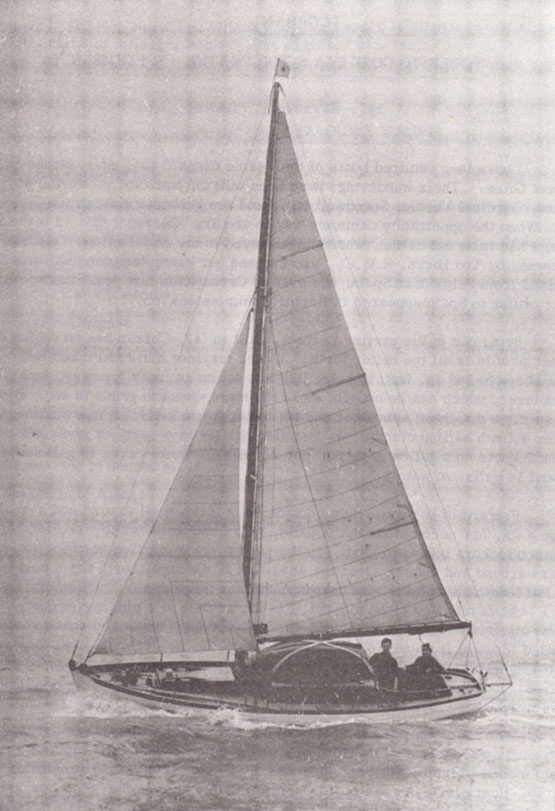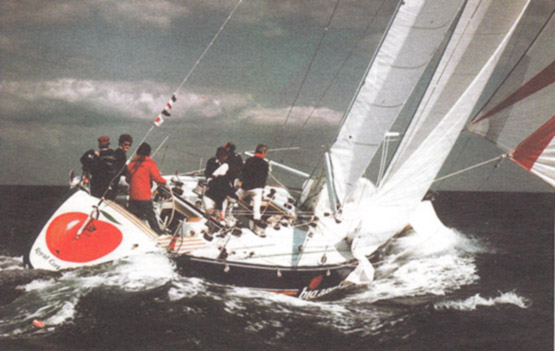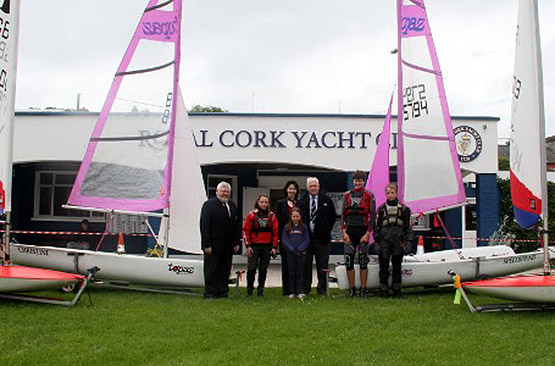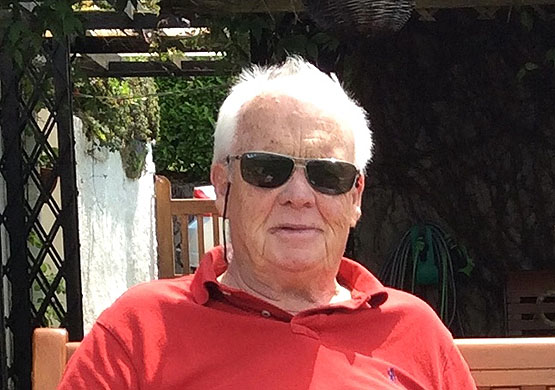With the death of Ray Fielding at the age of 80, Irish sailing in general and Cork sailing in particular has said farewell to an enthusiast whose active involvement, combined with fascination and knowledge in the lore and technology of boats and sailing, had few equals. While cruising was his main interest, for a brief period in the 1970s he was involved with international offshore racing at the highest level. But perhaps the most interesting aspect of his long life afloat was the sheer variety of boats he owned, each one a very good example of her general type.
Though he did some medical training abroad in the early days of his profession as a radiologist, in his career in healthwork he was a Corkman through and through, quietly at the heart of things in the southern capital. This was the case in his sailing too. He was making his mark afloat in Cork Harbour by his late teens, crewing with the Cudmores – notably Harold Cudmore Senr with the 7-tonner Auretta – to such good effect that in 1956 at the age of 20 he became a member of the Royal Munster Yacht Club at Crosshaven, and qualified as a member of the Irish Cruising Club.
Thus at the time of his death he had achieved the notable total of sixty years membership of both organisations, and when - accompanied by many friends - he went to his final appointment this week, he was wearing his Royal Munster tie. For although he was officially recognised as a Royal Cork YC member of 1956 vintage since the amalgamation of the two clubs for the Royal Cork’s Quarter Millennium in 1970, like many old Royal Munster sailors he retained a special fondness for the original club setup at Crosshaven.
He also much enjoyed the details of club life and administration, and when in 1959 he successfully proposed his shipmate the, 15-year-old Harold Cudmore Jnr, for membership of the Irish Cruising Club, in his accompanying letter he delighted in telling the Commodore and committee how the candidate not only improved the sailing aspirations aboard the boat by ensuring that she was always performing at her full potential, but even more importantly, although young Harold was a good seaman and an excellent helmsman, best of all he was a really superb sea-cook……

Ray and Christine Fielding’s first jointly-owned cruising boat was Corran, a classic Laurent Giles-designed Vertue, which they bought in 1966.
With marriage to Christine, Ray Fielding began to think of a proper cruising yacht they might own and use together, and their first boat – the classic 1948-built 25ft Laurent Giles Vertue Class Corran, Vertue No 12 which they bought in 1966 – was the first of an exceptional selection of interesting and able craft which included a Holman & Pye-designed Northney 34, an Angus Primrose Warrior 35, and then a selection of the new Bill Dixon-developed Moody yachts.
Although these were theoretically standard production boats, with his encyclopaedic knowledge and informed enthusiasm, Ray Fielding was a welcome visitor to the Moody production line when his boats were going through the building process. David Moody later recalled that many of the suggestions Ray made for incorporation in his largest boat from the firm, the ketch-rigged Moody 42 Spellbound, were later installed as standard in subsequent boats.

Ray and Christine Fielding’s largest cruising yacht was to be the Moody 42 Spellbound – he took a close interest in the construction and completion, and many of his suggestions for his own boat were incorporated as standard in subsequent sister-ships.
With these boats his cruises were numerous and extensive, and while many Cork cruising folk automatically think of heading south for warmer climes when they leave their home port, Ray Fielding on occasion would determinedly head north, logging at least three round Ireland cruises and savouring the Scottish Hebrides in all their variety, though in other years he would heed the siren call of the south. North or south, his cruising achieved wider recognition, and in 1970 he was elected a member of the Royal Cruising Club, while in 1971 he became Rear Commodore of the Irish Cruising Club, where he also served on the Committee for many years.
In the midst of the 1970s, he undertook the great adventure of going into partnership in 1977 with Clayton Love Jnr and Hugh Coveney in the hugely competitive state-of-the-art new Ron Holland-designed 44ft Big Apple, which in that year recorded Ireland’s first race win in the Admiral’s Cup. But although the boat also won the Concours d’Elegance for the best-presented yacht in the entire fleet, one year in this rarefied atmosphere was enough for Ray Fielding, and he happily returned to total cruising.

A leap in the dark. For a totally dedicated cruising man, Ray Fielding’s one year of involvement in the successful Ron Holland 44 Big Apple was a very new direction. Photo courtesy RCYC
He was fondly remembered this week as someone who would go the extra distance to make potential enthusiasts feel more at home. Photographer Robert Bateman recalls a distant time when he personally was Cobh-based, but was heading out past Crosshaven through the entrance to Cork Harbour in his new little home-finished dory when Ray and Christine came in through the harbourmouth under spinnaker in their Warrior 35 Ballerina of Skelligs, returning from a cruise. A photograph was taken, it was sent to the Fieldings, and out of the blue came an invitation to go out for a breezy afternoon’s sailing on Ballerina which resulted in the Batemans of Cobh being drawn into the heart of the Crosshaven scene.
As he and Christine had no children, over the years Ray Fielding’s succession of boats became his family. With his practical approach to seafaring, it was fascinating to watch the realistic way he down-sized his craft with advancing years. Like many others, he discovered that a Moody Eclipse is ideal for a certain stage in life, and at the very end he was in contented command of a Jeanneau Merry Fisher 665. As for his cruising grounds, he reckoned he was blessed as all Cork sailors are, with the paradise of West Cork just a short hop down the coast - who would wish to go anywhere else?
But with the death of Christine three years ago, he re-focussed his life for his latter days, and started to think of philanthropy. But being Ray Fielding, he went way beyond simply donating to some impersonal good cause. On the contrary, he sought out specific and un-met local needs with a maritime emphasis, and made the plans and resources available to meet them. Thus he funded the provision of two Toppers and two Topaz Unos to be available in Crosshaven for local youngsters, and after the Tit Bonhomme fishing boat disaster at the entrance to Glandore Harbour a couple of years ago, it was Dr Raymond Fielding who provided the means and put in the behind-the-scenes work to ensure that Glandore Harbour acquired its own inshore rescue boat.

For the presentation of the dinghy flotilla to the Royal Cork with Admiral Pat Lyons (left), donor Ray Fielding had to be frog-marched into the middle of the group.
In his final years as a widower, he found solace in a paternal interest in the day-to-day life of the Royal Cork Yacht Club in Crosshaven, where Ann Lordan in the bar kept a motherly eye on his wellbeing, while in the outside world of boats he found a kindred spirit in the shared enthusiasm of Dick Gibson, who encouraged and supported his continuing interest in everything to do with boats, their maintenance and development.

Summer contentment. The late Ray Fielding at his ease in Dick Gibson’s garden, August 2015. Photo: Dick Gibson
One of his final gestures for the Royal Cork in Crosshaven was made through the discovery that the antique globe light, which had originally provided gaslit illumination in the hallway of the old Royal Cork YC building in Cobh, was neglected and in danger of being forgotten. He arranged for it to be completely restored at a specialised workshop in Cork, and properly converted for use with electric power. It was a classic Fielding project in its attention to detail. And while it began while Peter Deasy was Admiral, the new light was finally installed with Pat Lyons as Admiral, becoming the centrepiece of the Globe Restaurant in the clubhouse, a very tangible link to the long and extraordinary history of this unique club.

The beautifully restored antique Victorian Globe Light is the centrepiece of the Royal Cork YC restaurant, a direct link to the history of the club more than 150 years ago, and a benevolent memorial to Ray Fielding
Yet in the various ceremonials involving the restored Globe, the new dinghy flotilla, and the inshore lifeboat at Glandore, Ray Fielding wished only to stay quietly in the background. For the photo of the new dinghy flotilla at Crosshaven, he had to be frog-marched into the middle of the group. It was the same when the inshore lifeboat for Glandore Harbour was presented at Union Hall. Ray Fielding much preferred to spend the final years of his interesting and well-lived life doing good work by stealth.
WMN
































































